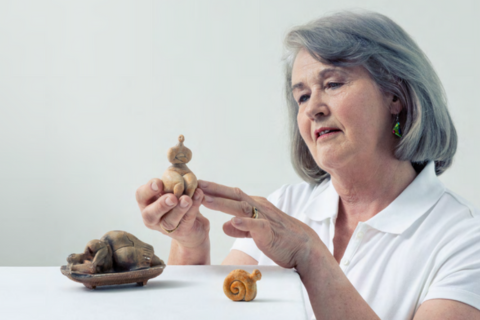Civilisations
Can culture survive climate change? Professor Caroline Malone reckons we should ask the Neolithics.

“No man is an island”, the metaphysical poet John Donne famously wrote, and – to archaeologists like Professor Caroline Malone, who has wielded her trowel and a remarkable array of scientific instruments under the baking Maltese sun for more than three decades – an island may be an excellent microcosm for studying humankind. Of clearly defined size, isolated from the varied cultural and biological influences of larger land masses, they present an excellent study subject through which to explore foundational questions of human societies’ beginnings, flourishings and falls.
In the case of Queen’s FRAGSUS project, which studies the Neolithic civilisations that flourished in Malta between 5300 BC and 3000 BC, the islands are also an excellent environment in which to tackle difficult questions. “I devised the project to combine an environmental mystery with the study of a remarkable population we’d excavated, as well as an intriguing economic story,” explains Malone, the founding scholar of FRAGSUS. (The project’s full title is ‘FRAGility and SUStainability in restricted island environments: Adaptation, Culture Change and Collapse in prehistory’.)
It’s a mystery large enough to have occupied an entire professional lifetime. The origins of FRAGSUS lie back in the mid-1980s, when Malone was finishing her PhD. And while no mystery is ever entirely solved, many revealing and powerfully relevant answers have emerged from the decades of research carried out by Malone and a large international team. “We’ve had more than 70 students, around 15 postdocs and 19 senior academics from Belfast, Malta and Cambridge working on this project,” she notes. “It’s launched several careers and we’ve really been able to grow capacity in people’s skills.”
It began when Malone and her husband, archaeologist Simon Stoddart, visited Malta in 1986 and were offered any site they wanted to excavate. They selected a location first excavated in the 1820s, recently rediscovered by a local man who had recognised the landscape depicted in a watercolour from that period. The site turned out to be extraordinary. “We excavated until 1994 and in that time discovered an enormous filled-in cave system that contained the remains, in disarticulated bits, of more than a thousand people. It was the first major excavation of a large population.” Alongside the human remains were figurines and a wealth of scientific information.
But that first phase of work generated as many questions as answers.
“We found that after Neolithic peoples arrived in Malta from Sicily and the eastern Mediterranean around 5800 BC, they cut down all the trees. Arboreal pollen was reduced, and was replaced by grasses and weeds, and the islands may then have been abandoned for a millennium,” Malone explains. “We felt this was central to understanding environmental change during the Maltese Temple Culture.”
ENVIRONMENTAL MYSTERY
Those initial findings framed the “environmental mystery” that was to define the FRAGSUS project for the next two decades. “The picture we had from the pollen samples, combined with the people we’d excavated, spanned 3800 to 2400 BC – a significant culture that recolonised Malta and survived intact without a break for almost 1,500 years,” says Malone. “That was an uncommonly long span. Normally, such cultures are more boom and bust. Populations arrive, grow, then disappear again. But on a small island with very limited environmental capacity, these people had to find a way to sustain life, and that endured – right up until it ended.”
FRAGSUS delved into the economic story of what people ate, farmed and built. “You have a whole nation stuck in this tiny space that’s smaller than Northern Ireland’s Lough Neagh,” Malone explains. “We wanted to know how many people there were, how they lived and, especially, what they did to the place to destroy ongoing opportunities.”
To do so, the FRAGSUS team drew on a wide array of established and emerging analytical techniques – to extract environmental data from pollen, soil, human and faunal remains, and molluscs-invertebrates – that would yield information about human diets, and isotopes indicative of climatic conditions. “Such data provides a solid base upon which to explore past human impact on the natural environment, and to identify how humans managed to cope when the resources of the natural world began to fail their needs,” Malone and co-authors wrote in the first of their landmark three-volume findings. “FRAGSUS was designed to explore and record a long human sequence that could challenge established theories and interpretations.”

Despite constantly evolving technology, and what Malone describes as “a very good team of young people” conducting the fieldwork, Malta’s environment didn’t easily yield up its secrets. There’s no lake or river on the island, making it hard to get to ancient pollen, which had to be sourced in hard-to-access sea valleys. Soil core sampling is a challenge in an environment that’s notorious for soil loss. “Every autumn there is heavy rain, then every summer it dries up, so soil is either washed or blown away. Thousands of years of soil build-up can be lost in a very short time,” says Malone. “It’s so relevant around the world today – we need to look after our soil.”
The picture built up by FRAGSUS’s multi-stranded approach was of a human occupation of Malta that ended around 5000 BC, followed by a thousand years of sporadic presence, but no sustained settlement. After that, the island was resettled. The cultural evidence, such as pottery, points to communities from Sicily, “but within a generation or two it becomes different. Malta’s civilisation is on its own path, completely cut off. And you can see, even today with migrants crossing the Mediterranean, how Malta is a difficult island to reach.”
These people really dug in, says Malone: there’s significant population growth and a consolidation of agriculture. The FRAGSUS team discovered these people ate beans, peas and barley, as well as wheat. Bone remains suggest domesticated animal populations were small, because on an island with no rivers, only springs, it’s not easy to keep a milking cow that requires 70 litres of water a day – “a reminder that even today, large-scale dairy farming is incredible demanding on resources,” notes Malone. Researchers have nonetheless discovered pottery containing milk products – evidence of cheesemaking – and isotopic study of human bones implies milk consumption.
This is a civilisation that achieved equilibrium by living within its resources. “One cow, one pig and 12 sheep seemed to be standard,” says Malone, “indicating that’s the sustainable limit for a household unit. And, in fact, that ratio continues right through to the 18th and 19th centuries in Malta.” Without the capacity to raise many animals to maturity, beasts would be slaughtered early. That created opportunities for feasts, and there is evidence for spectacular feasting sites at the structures that give the Maltese Temple Culture its name.

“Many of the temple structures are created as arenas,” says Malone. “There are tethering points, storage facilities and large deposits of pottery and cooking equipment. Young bullocks were probably slaughtered and the entire community would come together, boil up the meat and feast.”
Over time, as the landscape became progressively desiccated, evidence reveals people eating less meat and more cereal and almost no marine food. “They were probably under dietary stress,” Malone observes. There was another kind of population pressure revealed by DNA sequencing from unusually challenging remains – the suitability of bone for this type of analysis degrades quickly in warm southern European and north African climes. They revealed the “second most interrelated person ever found in Neolithic Europe”, the result of a union between close blood relatives that suggests very small populations.
By 2350 BC, the Temple Culture had all but disappeared, following major climatic events that caused widespread desiccation across much of the Mediterranean and north Africa. “The distinctive Temple Culture doesn’t survive after that,” says Malone. “The rituals and traditions have gone.”
Spanning more than 1,500 years of history, and 35 years of scholarship, what conclusions can be drawn from the fate of Malta’s prehistoric Temple people? “It shows us dramatically that living prudently and in balance with resources is fundamental,” Malone says. “With no balances, people are greedy for everything. But when there’s no opportunity to move, and what’s to hand is limited, people are much more resourceful with what they have. It’s a very compelling story for all people.”